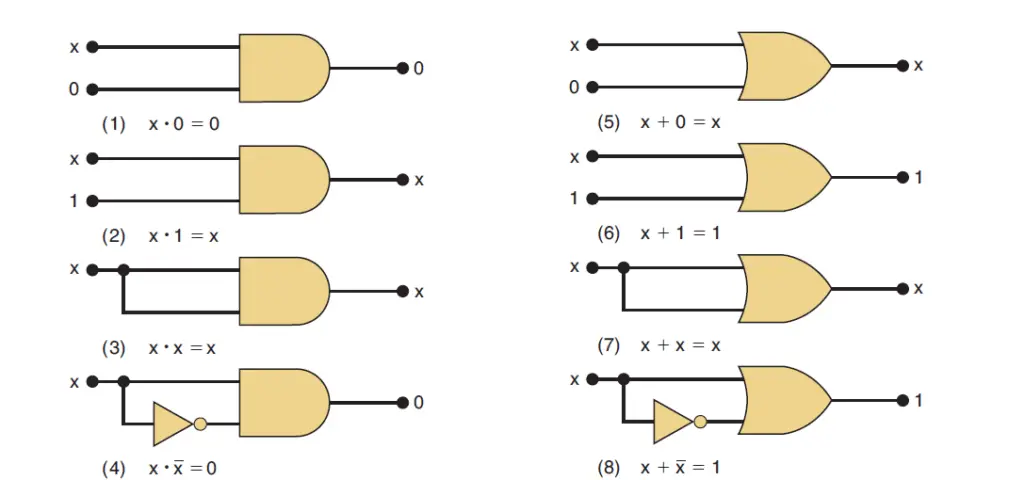Boolean algebra theorems | boolean theorems (rules)
Boolean algebra can be used to help analyze a logic circuit and express its operation mathematically. We will study Boolean algebra by investigating the various boolean theorems (rules) that can help us to simplify logic expressions and logic circuits.
Boolean theorems (rules of Boolean algebra)
The first group of theorems is given in Figure 1. In each theorem, x is a logic variable that can be either a 0 or a 1. Each theorem is accompanied by a logic-circuit diagram that demonstrates its validity.

Boolean algebra theorem 1
Theorem (1) states that if any variable is ANDed with 0, the result must be 0. This is easy to remember because the AND operation is just like ordinary multiplication, where we know that anything multiplied by 0 is 0. We also know that the output of an AND gate will be 0 whenever any input is 0, regardless of the level on the other input.
Boolean algebra theorem 2
Theorem (2) is also obvious by comparison with ordinary multiplication.
Boolean algebra theorem 3
Theorem (3) can be proved by trying each case. If x = 0, then 0 . 0 = 0; if x = 1, then 1 . 1 = 1. Thus, x . x = x.
Boolean algebra theorem 4
Theorem (4) can be proved in the same manner. However, it can also be reasoned that at any time either x or its inverse must be at the 0 level, so their AND product always must be 0.
Boolean algebra theorem 5
Theorem (5) is straightforward since 0 added to anything does not affect its value, either in regular addition or in OR addition.
Boolean algebra theorem 6
Theorem (6) states that if any variable is ORed with 1, the result will always be 1. We check this for both values of x: 0 + 1 = 1 and 1 + 1 = 1.
Equivalently, we can remember that an OR gate output will be 1 when any input is 1, regardless of the value of the other input.
Boolean algebra theorem 7
Theorem (7) can be proved by checking for both values of x: 0 + 0 = 0 and 1 + 1 = 1.
Boolean algebra theorem 8
Theorem (8) can be proved similarly, or we can just reason that at any time either x or its inverse must be at the 1 level so that we are always ORing a 0 and a 1, which always results in 1.
When theorems (1) through (8) are applied, the variable x may actually represent an expression containing more than one variable.
Multivariable theorems
The theorems presented below involve more than one variable:

Theorems (9) and (10) are called the commutative laws. These laws indicate that the order in which we OR or AND two variables is unimportant; the result is the same.
Theorems (11) and (12) are the associative laws, which state that we can group the variables in an AND expression or OR expression any way we want.
Theorem (13) is the distributive law, which states that an expression can be expanded by multiplying term by term just the same as in ordinary algebra. This theorem also indicates that we can factor an expression. That is, if we have a sum of two (or more) terms, each of which contains a common variable, the common variable can be factored out just as in ordinary algebra.
Theorem (14) can also be proved by factoring and using theorems (6) and (2).
Take Away
All of these Boolean theorems can be useful in simplifying a logic expression—that is, in reducing the number of terms in the expression.
When this is done, the reduced expression will produce a circuit that is less complex than the one that the original expression would have produced.
